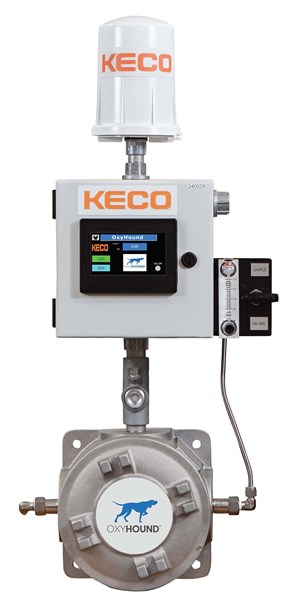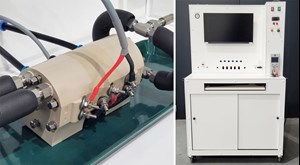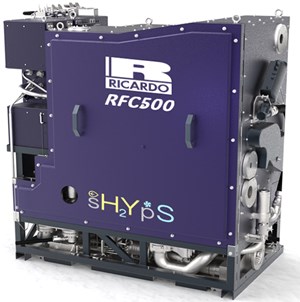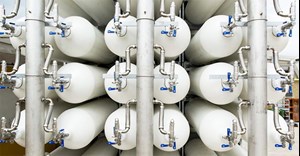Articles
H2Tech: Tech Spotlight
H2 PRODUCTION
Stargate Hydrogen to unveil new alkaline stack for green H2 production
Stargate Hydrogen, a company that specializes in the manufacturing of electrolyzers for green hydrogen (H2) production, announced the launch of their new alkaline electrolysis stack during the World Hydrogen Summit in Rotterdam.
Green H2 is an effective way to drastically cut industrial carbon dioxide (CO2) emissions in processes which traditionally have relied on fossil fuels. An electrolysis stack is the heart of a system for green H2 production, and the properties of the stack often determine the key metrics, such as the efficiency and production rate of such a system.
The electrolysis stack, named Stellar 100, is manufactured in Europe and has a green H2 production capacity of up to 100 cubic meters per hour (Nm3/hr), meaning that each hour it produces enough energy to power a car for 1,000 kilometers (km).
Designed to fit in pairs in a standard maritime container, the stack can be configured to meet specific customer needs. Its patented design was developed by Stargate in cooperation with European suppliers and tested by the Center for Solar Energy and H2 Research Baden-Württemberg, a renowned German research institute.
Researchers reduce the amount of iridium needed for H2 production
Researchers led by Ryuhei Nakamura at the RIKEN Center for Sustainable Resource Science (CSRS) in Japan have reported a new method that reduces the amount of iridium needed for the reaction by 95%, without altering the rate of H2 production. This breakthrough could revolutionize the ability to produce ecologically friendly H2 and help usher in a carbon-neutral H2 economy.
Current global energy production is almost 18 terawatts (TW), meaning that at any given moment, about 18 TW of power are being produced on average worldwide. For alternative green methods of energy production to replace fossil fuels, they must be able to reach the same rates of energy production.
Extracting H2 from water is an electrochemical reaction that requires a catalyst. The best catalysts for this reaction—those that yield the highest rate and the most stable H2 production—are rare metals, with iridium being the best of the best. However, the scarcity of iridium is a significant challenge.
The bio-functional catalyst research team at RIKEN CSRS is trying to get around the iridium bottleneck and find other ways of producing H2 at high rates for long periods of time. In the long run, they hope to develop new catalysts based on common earth metals, which will be highly sustainable. The team recently succeeded in stabilizing green H2 production at a relatively high level using a form of manganese oxide as a catalyst. However, achieving industrial level production in this manner is still years away.
With the new catalyst, continuous H2 production was possible for over 3,000 hr (about 4 mos) at 82% efficiency without degradation. The team has begun collaborating with partners in industry that have already been able to improve on the initial iridium-manganese catalyst. Moving forward, the RIKEN CSRS researchers plan to continue investigating the specific chemical interaction between iridium and manganese oxide, with hopes of reducing the amount of necessary iridium even more.
H2 EQUIPMENT
Honeywell Forge releases UniSim® for green H2 modeling
Honeywell Forge’s UniSim R491 has been equipped with green H2 process models to enable the design and validation of green H2 processes through electrolyzer model unit operations and standard templates and prebuilt green H2 process flowsheets. This technology can create a standard green H2 template flowsheet for a generic alkaline electrolyzer with pre-defined parameters like polarization curve, current density, conversion and efficiency to assist in the design and simulation of green H2 processes.
The UniSim R491 can also pre-design a proton exchange membrane (PEM) unit operation with prebuilt performance correlations usable in design or rating mode. The electrolyzer models contain modifiable parameters to match the technology licensor’s information and to evaluate design specifications. The key capabilities of this technology are:
- A prebuilt, self-contained green H2 template
- A user customizable alkaline electrolyzer model
- PEM unit operation
- REFPROP thermodynamic engine
- Balance-of-plant (BoP) simulations
- Auxiliary equipment sizing calculations benefits
- Evaluating licensor-specific information on electrolyzers
- Conducting feasibility studies for facility design
- Building the BoP simulations for capital expenditure (CAPEX) estimating.
The pre-built green H2 design templates come complete with all auxiliary equipment and connections needed to simulate green H2 processes. The flowsheets can connect to plant process flowsheets and water purification plants.
The electrolyzer models come standard with predefined parameters. Users can customize electrolyzer parameters and efficiencies to match technology licensors information. The PEM unit operation contains prebuilt performance correlations and can be used in design or rating mode. Variables, which can be either specified or calculated, include current density, cell voltage, stack power, membrane properties, electrode information and water transport properties.
UniSim has integrated REFPROP, which is a combination of a reference fluid thermodynamic and transport properties database and property package. It adds to UniSim’s expanding range of capabilities to model complex fluids in various pressure and temperature regimes, such as those required for modeling of high-pressure H2 from green H2 plants.
Process oxygen analyzer precisely calculates natural gas, biogas and other gas streams in real time
KECO has introduced the OxyHound, a highly-efficient process gas analyzer that conducts real-time and continuous oxygen analysis of natural gas, biogas and other gas streams. Utilizing optical quench luminescence technology for gaseous sampling, this cost-effective analyzer conducts precise oxygen measurements in a gaseous phase (ppmv and % on a molar basis) with no cross-sensitivity with CO2, hydrogen sulfide (H2S), ammonia (NH3), sulfur oxide (SO2), sulfate or other ionic species.
OxyHound technology is based on the phase modulation of an oxygen-specific luminophore's luminescent decay time, which enables accurate calculation of oxygen's partial pressure. The oxygen analyzer measures the phase shift and intensity variation between the excitation light and the fluorescent response. From these measurements, the analyzer’s onboard computer precisely calculates oxygen in real time.
With a user-friendly and low-maintenance design, the OxyHound eliminates the need for electrolyte changes or membrane maintenance. Utilizing KECO Cloud Connect, users can remotely monitor the analyzer on any web-connected device using LTE-M. These features can work as an oxygen analyzer or meter (data logger). This makes the OxyHound an ideal replacement for older technologies, such as paramagnetic analyzers, electrochemical cells, and in some instances, zirconia and tunable diode laser (TDL).
Built for Division 2 and Zone 2 hazardous locations, the OxyHound operates in a range of environments with contaminants such as H2S, CO2, H2, propylene, methanol and ethanol mixtures. A reliable choice for indoor and outdoor settings, the gas analyzer serves various industries including natural gas pipelines, refineries, biogas, chemical plants, landfills, wastewater treatment, manufacturing, food and beverage, and renewables.
For example, in the oil and gas sector, the process gas analyzer can measure traces of oxygen levels in various operations from vapor recovery units to enhanced oil recovery processes. In renewable energy applications, including bio-gas and ethanol production, the OxyHound excels in environments with contaminants such as H2S, CO2 and H2. In addition, the oxygen gas analyzer is ideal for manufacturing sectors such as fiber optic production and annealing furnaces.
Zero Emission Industries launches FTcase to bring safe, easy and flexible H2 fueling to all markets
Zero Emission Industries (ZEI) has unveiled its FTcase, a portable H2 refueling solution barely larger than carry-on luggage. FTcase eliminates the complexities of gaseous H2 refueling and simplifies the process for all markets. This product enables the rapid deployment of H2-powered vehicles and heavy-duty equipment, eliminating a major barrier to widespread H2 adoption: the complete lack of accessible and convenient fueling infrastructure.
Safe H2 fueling of large-scale machinery has meant complicated processes, equipment and infrastructure that are massively expensive and notoriously unreliable. Past options included:
- Moving vehicles or equipment to an existing H2 fueling station, which are few and far between.
- Building an exorbitantly expensive refueling installation somewhere near the equipment.
- Engaging so-called "mobile" solutions that involve huge trailers with low availability, frequent downtime and high costs.
ZEI’s field-validated, software-controlled technology aims to ensure the safety of every fueling operation. Designed for safety and reliability, the FTcase integrates advanced fail-safe systems, minimizing risks and consistently exceeding stringent safety standards.
Oxford nanoSystems introduces new testing solutions to accelerate green H2 R&D
Oxford nanoSystems Ltd., a developer of innovative nano coating technologies, has launched its ElectroFlow ETS20 Multi-cell Electrolyzer Test Station and ElectroFlow MTF Multi-cell Electrolyzer Test Fixture. This equipment has been specifically designed to accelerate research and development (R&D) in electrolysis technology.
The demand for green H2 is rapidly growing. This surge is driven by H2's potential to decarbonize various industries and contribute to achieving net-zero emissions targets. However, large-scale adoption hinges on reducing the production cost of green H2, which requires significant advancements in electrolyzer performance.
Oxford nanoSystems’ new products address this critical need by offering material, component and streamlined testing solutions for electrolyzer researchers to accelerate the R&D process. By enabling parallel testing of multiple electrolyzer cells, the ElectroFlow solution provides a significant key benefit: efficient material evaluation. Electrolyzer scientists and engineers can effectively assess the performance of key cell components, such as membranes, electrodes and coatings.
The ElectroFlow ETS20 is also ideal for gaining familiarity with the operating principles of electrolyzer systems, as well as methods for testing and analysis of electrolyzer cells and components.
Emerson releases pressure regulator to maximize H2-powered vehicle fuel efficiency
Emerson has launched the TESCOMTM HV-7000 Series two-stage pressure-reducing regulator, which is designed to maximize fuel efficiency and improve reliability in H2-powered vehicles. The HV-7000 Series regulators provide stable pressure delivery, high reliability and long service life for heavy-duty vehicles powered by fuel cells or H2 combustion engines.
The HV-7000 features two-stage pressure reduction and a positive seal designed to deliver H2 to the fuel cell at optimal pressure in all flow conditions, even as the vehicle’s H2 storage tank depletes. The two-stage pressure reduction significantly lessens the decaying inlet characteristic compared to single-stage regulators, while the positive seal design offers superior shut-off performance. Together, these features can minimize fueling costs and the risk of downstream component failure and downtime.
The most common cause of regulator failure is contamination, which can damage soft goods such as seats and seals, causing leakage and vehicle downtime. HV-7000 features such as tied valve stems, integrated filters and patented redundant seals make the regulator contamination-resistant, improving vehicle service life and extending time on the road.
The redundant seal design extends cycle life if one seal experiences wear, the filter catches solid particles produced during installation before they can contact soft goods, and the tied valve stem counteracts seat contamination and wear. Preventing contamination and resulting leaks can help avoid fuel loss, safety hazards, system damage and equipment downtime.
In addition to its benefits for the vehicle’s user, the HV-7000 is also designed to help fuel cell system manufacturers and integrators assemble the regulator into their system as quickly as possible. The regulator is compact and lightweight, with a flat shape and mounting holes designed specifically for mounting the regulator against other flat surfaces in the system. Such easy installation helps reduce manufacturing and procurement costs and eases scale-up as production volumes increase compared to other pressure regulation technologies.
H2 APPLICATIONS INNOVATION
PACECO and MITSUI E&S debut H2 fuel cell RTG crane at Port of Los Angeles
PACECO Corp. has announced the commencement of commercial operations of a H2 fuel cell-powered rubber-tired gantry (RTG) crane at the Port of Los Angeles, California (U.S.). The H2-ZE RTG Transtainer Crane, developed in collaboration with MITSUI E&S and funding from the Japanese New Energy and Industrial Technology Development Organization (NEDO), began operations at Yusen Terminals Inc. (YTI).
The H2-ZE RTG Transtainer Crane runs 100% on H2 fuel-cell technology, enabling the ability to achieve zero emissions on large container cranes without connecting to the electric grid. The H2 fuel cell-powered zero-emissions RTG crane was developed by MITSUI E&S in collaboration with PACECO and built by MITSUI E&S in Japan. The fuel cell power pack (FCPP), an efficient power system replacing a typical diesel genset, was designed and built by MITSUI E&S in Oita, Japan, with H2 being provided by Toyota Tsusho for this project. The modification of existing conventional diesel RTGs is possible to achieve zero emissions with the FCPP system.
A typical diesel-powered RTG crane emits the CO2 equivalent of burning more than 400 barrels of oil per year (bpy), while the H2-ZE RTG Transtainer Crane is carbon neutral. This pilot project, scheduled to run over the next 4 yr at Yusen Terminals at the Port of Los Angeles, demonstrates PACECO’s commitment to sustainable port logistics, aligning with global efforts to reduce port emissions while embracing zero-emissions technology.
Ricardo secures Lloyd’s Register approval in principle (AiP) for innovative H2 solution for maritime
Ricardo has received an AiP from Lloyd's Register for the design of its multi-MW containerized fuel cell power plant solution. The technology has been designed and developed by Ricardo as part of the Sustainable Hydrogen Powered Shipping (sHYpS) project. Ricardo is the fuel cell system partner in the sHYpS project, which includes the specification, design, build and test of a ~500-kW gross, 375-kW net power fuel cell module (RFC500), and the design of a 40-ft containerized multi-megawatt power plant that combines the outputs of several fuel cell modules.
H2 STORAGE AND TRANSPORTATION APPLICATIONS
Tenaris launches THera™ Seal
Tenaris introduced THera™ Seal, a new sealing solution for high-pressure gaseous H2 storage, at the World Hydrogen 2024 Summit held at the Rotterdam Ahoy complex in Rotterdam, Netherlands. Leveraging Tenaris's expertise in metal-to-metal connections for extreme weather conditions, the design of THera™ Seal introduces an innovation that enables seamless integration between the vessel and the sealing system, eliminating the need for additional elastomeric seals, O-rings or gaskets to maintain pressure integrity. This sealing solution provides robustness and versatility, guaranteeing exceptional gas sealability for high-pressure H2 applications. H2T









